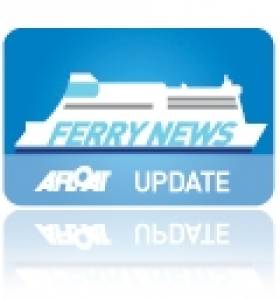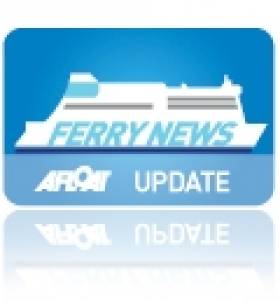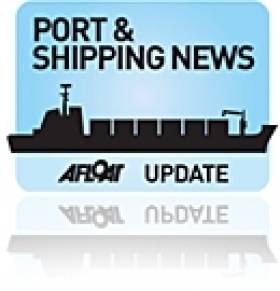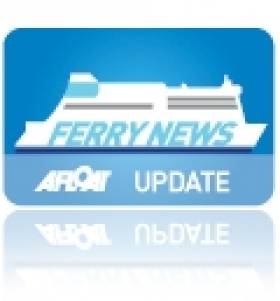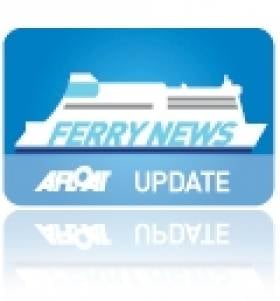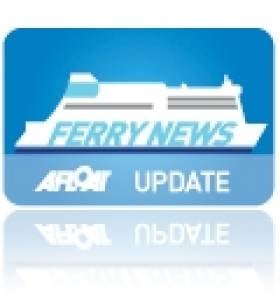Displaying items by tag: Celtic Link Ferries
French Route Ferry to Dry-Dock Leaves Single Service Operator
#FERRY DRYDOCKING - Only two round trip Irish Ferries operated Rosslare-Cherbourg sailings are to remain before the year is out, writes Jehan Ashmore.
The cruiseferry Oscar Wilde is to undergo annual maintenance and routine inspection during January before opening the French service in late February 2013.
In the interim period this leaves Celtic Link Ferries which also runs to Cherbourg, as the only operator serving a direct year-round service using the ro-pax ferry Celtic Horizon.
The third operator on the Irish-French market, Brittany Ferries whose flagship Pont-Aven completed sailings for this year in early November.
Sail to Ireland with Celtic Link for Next to Nothing!
#FERRY NEWS - Celtic Link Ferries have announced their best ever ferry deal between France and Ireland to coincide with The Gathering 2013.
On Friday 15 March 2013 - in time for the St Patrick's Weekend festivities - all vehicles will sail from Cherbourg to Rosslare Europort for just €1 each.
The fantastic deal is inclusive of a vehicle, cabin and the people in the cabin - but act fast, as this 'next to nothing' offer is available for this one day only.
“Celtic Link Ferries are simply bringing in as many passengers as they can - for as little price that they can,” says passenger manager Rory McCall.
Bookings for this day can be made at www.celticlinkferries.com.
French Ferry Sailings Set to Resume Service
#FERRY TO RESUME – Services on Celtic Link Ferries Rosslare-Cherbourg route as previously reported on Afloat.ie are scheduled to resume with tomorrow (20 November) night's sailing departing 21.30hrs.
According to the ferry operator, the ro-pax ferry Celtic Horizon will be operating to a reduced capacity, however the sailing will mark the return of standard sailing times.
Due to the restrictions in place any passenger with special needs are requested to contact CLF on 053 916 2688 (Ireland) or 02 33 43 23 87 (France) and for further information visit www.celticlinkferries.com
No Ferry Sailing due to Mooring Issue in Cherbourg
#NO FERRY SAILING – Due to a mooring issue that took place in Cherbourg, there will be no sailing today (18 November) on Celtic Link Ferries 19.00hr departure from Cherbourg to Rosslare.
According to the operator's website, yesterday's outward sailing from Rosslare was also cancelled and that passengers intending to travel today will also be looked after on other sailings. In the meantime the ro-pax vessel remains berthed at Rosslare Europort.
To keep updated of further developments passengers are requested to consult the operators website HERE and by contacting CLF on 053 916 2688 (Ireland) or 02 33 43 23 87 (France).
Ports & Shipping Review: Celtic Link Ferry 1st Year, Collision in Rosslare,Ports to Gain from Energy Sector, Volunteers for Tallship Dry-Docking and More...
#PORTS & SHIPPING REVIEW - Over the last fortnight Jehan Ashmore has reported from the shipping scene where Celtic Link Ferries celebrated their first year in service of the ro-pax ferry Celtic Horizon which operates the Rosslare-Cherbourg route.
Also in Rosslare, Stena Line's Fishguard ferry Stena Europe attempted to berth in high winds which led to the vessel making contact with the bow of Irish Ferries cruiseferry Oscar Wilde.
Further ferry news, though from Cork where last weekend saw the final end of season round-trip sailing to Roscoff operated by Brittany Ferries cruiseferry Pont-Aven.
According to the Irish Maritime Development Office (IMDO), Irish Ports are in a good position to capitalise on the growing demand for offshore renewable energy services.
Following the tallship Tenacious 'Open Day' in Dublin Port in late October, the 65m long barque returned to Dublin Bay, but instead made an overnight visit to Dun Laoghaire with 28 crew trainees on board. Her owners the Jubilee Sailing Trust are looking for volunteers to carry out tasks while she undergoes dry-dock this month.
Turnover in the Dublin Port Company has edged fractionally higher in 2011 at €69.1m and operating profit also slightly increased by €0.8m to €27.8m on 2010 figures.
An apt office location for Decisions (D4H) a software firm specialising in emergency response technology has made its new home at a building block adjacent of the Baily Lighthouse in Dublin Bay.
A Year on the Horizon for Celtic Link's Ro-Pax Ferry
#CELTIC LINK - The Celtic Horizon, the 27,522 tonnes ro-pax ferry this week celebrates her first year in service on Celtic Link Ferries Rosslare-Cherbourg route, writes Jehan Ashmore.
According to the Celtic Link they have had a 'resoundingly successful inaugural year with the Celtic Horizon'. The Co. Wexford based operator saw double digit-growth in the number of tourist passengers sailing on the 17 hour route.
Celtic Link envisage that this growth will continue in 2013 and as the only year-round operator between Ireland and France. On the freight front, strong performance has been recorded despite the turbulent economic conditions in which the company has claimed to have performed in line with yearly forecasts.
The 1000 passenger capacity ferry, with space for 200 cars and up to 120 freight vehicles, completed her first round trip voyage last October, having been chartered by CLF for a five-year term contract. On board the 186m vessel facilities include 110 cabins, a bar, restaurant, lounges, cinema, shop and wi-fi connectivity.
Celtic Horizon was built in 2006 by Cantiere Navala Visentini, Portoviro, in Italy and she retains her port registry of Bari. As the Cartour Beta, she began her career serving routes between Naples and Sicily for Caronte & Tourist (C&T) until her charter ceased late last summer.
Last September, the vessel was berthed in Palermo, in advance of her four-day delivery voyage to Ireland. The voyage set a course that saw her offshore of the Algerian coast and before leaving the Mediterranean, an en-route call was made to Gibraltar to load bunkers, until she finally reached Rosslare Harbour.
She has more passenger deck space compared to her predecessor, Norman Voyager, which likewise was built of the same overall ro-pax design of the Italian shipbuilder. A notable and novel feature is the escalator which whisks passengers from the vehicle decks to the main passenger deck.
Ports & Shipping Review: Stena HSS Comes and Goes, Shackleton Exhibition, Cork Harbour Open Weekend,Cargoship Dispute and Ferry Strike
#PORTS & SHIPPING REVIEW - Over the last fortnight Jehan Ashmore has reported from the Shipping scene where the Stena Line HSS seasonal-only operated Dun Laoghaire-Holyhead service completed its final sailing for the summer, though sailings are to resume over Christmas/New Year period.
Despite the HSS Stena Explorer's last high-season sailing on 11 September, the fast-ferry made a return call to Dun Laoghaire five days later, for a special freight-only charter, to load stage trucks following the Lady Gaga concert held in the Aviva Stadium, Dublin.
Incidentally the ferry terminal in Dun Laoghaire now features a new exhibition space, where the Tanaiste Eamonn Gilmore, T.D. officially launched the Shackleton Endurance Exhibition – 'Triumph Against All Odds'.
The Cork Harbour Open Weekend provided a great opportunity for locals and visitors alike to see what the world's second largest natural harbour has to offer, in terms of activities held on and off the water, including trips to Spike Island.
At Cobh a detained French registered fishing vessel was escorted to the town by the Naval Service OPV L.E. Roisin, following alleged breaches of technical fishing regulations.
A Dutch owned cargoship, the Julia, which docked in Drogheda Port faced arrest, following claims by its crew that they were owed in total $102,700 in unpaid wages to them.
The summer may be over, but that's not stopping Irish Ferries offering Autumn short shopping breaks and wine mini-cruises on the route to Cherbourg.
While rivals Celtic Link Ferries, found themselves taking additional business at short notice, as passengers were transferred from the cancelled Brittany Ferries Roscoff-Cork sailing, following strike-action by French staff over a dispute on new working conditions.
Celtic Link Ferries will however be expecting a response from customers as they take part in Gathering 2013, as the ferry operator are offering free car travel on 15th March next year in advance of St. Patricks Day celebrations.
Leo Varadkar, Minister for Transport, has appointed James Frater to the board of the Dublin Port Company. The Scot has held senior positions at ports in the UK, Egypt, Hong Kong and Oman.
A Celtic Link Voyage to The Gathering 2013
#FERRY NEWS – Celtic Link Ferries are to participant in Ireland's The Gathering 2013, a year-long initiative to celebrate all things Irish, with a unique opportunity to take a car from France on their Cherbourg-Rosslare service for free, writes Jehan Ashmore.
The special offer is limited to the sailing scheduled to depart Cherbourg on 15th March, with an arrival the next day to Rosslare Europort, in advance of the nation's annual celebrations on St. Patrick's Day.
Those travelling on this sailing will have the chance to sample the Celtic Horizon, the newest and fastest ship sailing on this route between Normandy and Wexford.
Among the facilities on board the 27,522 tonnes vessel is the forward facing restaurant, the Cherbourg Café Lounge and adjoining children's playroom, cinema and Wi-Fi. Accommodation is provided in 110 cabins and vehicle decks for 200 cars and up to 120 freight trucks.
For further details of The Gathering voyage and other offers visit: www.celticlinkferries.com
Inaugural High-Season for Celtic Link Ferries Newcomer
#CELTIC LINK – Rosslare-Cherbourg operator Celtic Link Ferries which runs the Celtic Horizon (2006/27,522grt) on the 17 hour route, is operating her first high-season, since the 940-passenger ship was introduced last October, writes Jehan Ashmore.
Celtic Link Ferries are the only company to provide an all year-round service on the Irish-French services which are also served by other operators running out of Rosslare and Cork.
The Celtic Horizon has larger and improved passenger facilities compared to predecessor Norman Voyager. Among the facilities on board the newcomer is the forward facing restaurant, the Cherbourg Café Lounge and adjoining children's playroom, cinema and Wi-Fi. Accommodation is provided in 110 cabins and vehicle decks for 200 cars and up to 120 freight trucks.
CLF have a short wine-break offer for a driver and companion, plus return car to stock up on your favourite French wines. The offer also includes a two berth outside cabin both ways and costs €200. For further, information click HERE.
Ports & Shipping Review: Port Trade Rise,Silver-Salvage, Ports Study, Ferries, 'Olympic' Cruiseships and New Ship
#PORTS & SHIPPING REVIEW - Over the last fortnight Jehan Ashmore has reported from the Ports & Shipping Scene which saw trade volumes in Drogheda Port continue to rise. An increase of over 44% was recorded for the first six months of 2012 compared to the same period last year.
Off the west coast, a record breaking 48 tonnes of silver bullion has been recovered from the wreck of S.S. Gairsoppa, a 412-ft British cargoship that was torpedoed by U-Boat in WWII.
The Competition Authority is to conduct an in depth review of how our ports perform and how they are to be funded and to examine whether Dublin Port has an economically dominant position.
A boost on all fronts for traffic figures on Stena Line's Belfast-Birkenhead (Liverpool) route was welcomed by the ferry operator which completed the takeover of operations from DFDS Seaways last summer.
Single-route operator Celtic Link Ferries reached an agreement with Rosslare Europort, to end a stalemate in over €100,000 relating to unpaid port landing fees.
Deutschland, one of the three cruiseships that visited Dublin Port last weekend completed its cruise in London, where the vessel is currently moored as a floating hotel for the German Olympic Sports Federation.
Belfast M.P. Nigel Dodds is leading a campaign to keep the WWI battleship cruiser HMS Caroline, the last survivor of the Battle of Jutland, from leaving the city. The 1914 built ship could be moved to Portsmouth for preservation or even face scrapping.
At the other end of the island, Cork based Irish Mainport Holdings has acquired a new seismic-support ship. The vessel renamed Mainport Kells has recently taken up a long-term charter contract for clients operating in the North Sea.



























